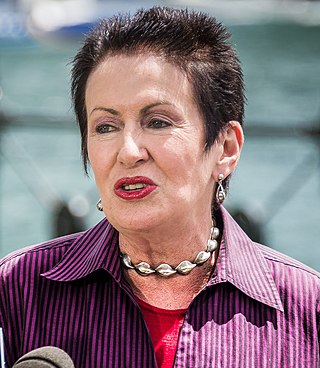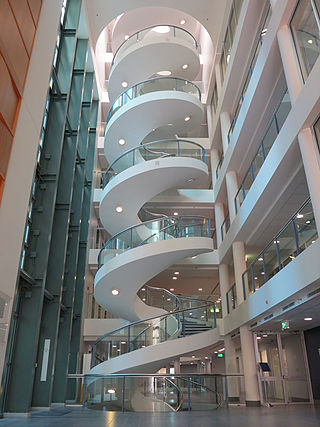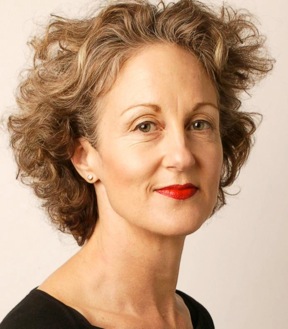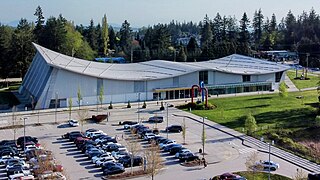
Clover Margaret Moore is an Australian politician. She has been the Lord Mayor of the City of Sydney since 2004 and is currently the longest serving Lord Mayor of Sydney since the creation of the City of Sydney in 1842. She was an independent member of the New South Wales Legislative Assembly from 1988 to 2012, representing the electorates of Bligh (1988–2007) and Sydney (2007–2012). Moore is the first popularly elected woman Lord Mayor of Sydney.

Darlington is a small, inner-city suburb of Sydney, New South Wales, Australia. Darlington is located about three kilometres south of the Sydney central business district and is part of the local government area of the City of Sydney. At the time of its incorporation in 1864, it had the distinction of being the smallest municipality in the Sydney metropolitan area, at a mere 44 acres. Darlington is bordered by City Road, Cleveland Street, Golden Grove Street, Wilson Street and Abercrombie Street.

Civic is the city centre or central business district of Canberra. "Civic" is a common name for the district, but it is also called Civic Centre, City Centre, Canberra City and Canberra, and its official division name is City.
Denton Corker Marshall is an international architecture practice based in Melbourne, Australia.
James Birrell (1928—2019) was an architect responsible for the design of significant buildings in Queensland, Australia. James Birrell practiced from 1951 to 1986.

Daryl Sanders Jackson is an Australian architect and the owner of an international architecture firm, Jackson Architecture. Jackson also became an associate professor at University of Melbourne and Deakin University.
The Sydney School of Architecture, Design and Planning, also known as The University of Sydney School of Architecture, Design and Planning, formerly the Faculty of Architecture, Design and Planning, is a constituent body of the University of Sydney, New South Wales, Australia. The school was established in 1920.

The El Alamein Memorial Fountain is a heritage-listed fountain and war memorial located at Macleay Street in the inner Sydney locale of Kings Cross in the City of Sydney local government area of New South Wales, Australia. It was designed by the Australian architects Robert Woodward and Phill Taranto as employed by architectural firm Woodward and Woodward. The fountain was built from 1959 to 1961. It is also known as El Alamein Fountain, Fitzroy Gardens Group, Kings Cross Fountain and King's Cross Fountain. It was added to the New South Wales State Heritage Register on 14 January 2011. The El Alamein Fountain was commissioned as a memorial to soldiers who died in 1942 during World War II in two battles at El Alamein, Egypt.
Neil Clerehan was an Australian architect and architectural writer.
Robert Raymond (Bob) Woodward was an Australian architect who gained widespread recognition for his innovative fountain designs.

Kenneth Frank Charles Woolley, BArch, Hon DSc Arch Sydney LFRAIA, FTSE, was an Australian architect. In a career spanning 60 years, he is best known for his contributions to project housing with Pettit and Sevitt, four time Wilkinson Award-winning architect, including three times for his own house, the first being the 1962 Woolley House in Mosman, and his longstanding partnership with Sydney Ancher and Bryce Mortlock. He is regarded as being a prominent figure in the development of the Sydney School movement and Australian vernacular building.

Elizabeth Margaret Farrelly, is a Sydney-based author, architecture critic, essayist, columnist and speaker who was born in New Zealand but later became an Australian citizen. She has contributed to current debates about aesthetics and ethics; design, public art and architecture; urban and natural environments; society and politics, including criticism of the treatment of Julian Assange. Profiles of her have appeared in the New Zealand Architect, Urbis, The Australian Financial Review, the Australian Architectural Review, and Australian Geographic.
Nicholas Phillip Murcutt was an Australian architect.

Colin Arthur Still ARAIA, was an Australian architect from Watsons Bay, in Sydney. As part of his involvement with the Australian Institute of Architects he served as a Vice President and Chair of the Environment Committee. As a landscape artist he was a finalist in several Wynne Prize exhibitions at the Art Gallery of New South Wales.
Professor Lawrence Nield is a retired Australian architect, who since 2012 has been head of the Heritage Council of New South Wales. He is also known for his writings on urban design. He was head of master planning for the 2000 Sydney Olympic Games. He was one of the founders of BVN Architecture.

Ian Thorpe Aquatic and Fitness Centre is a fitness centre in Ultimo, New South Wales, a suburb of Sydney, Australia. It has three swimming pools, exercise machines, and other facilities. The centre is co-managed by the City of Sydney and Belgravia Leisure. Named for swimming champion Ian Thorpe, it was one of the last buildings designed by architect Harry Seidler, and is noted for its curved roof design that suggests a breaking ocean wave.
Robert Harold Dickson was a South Australian architect. His many works contributed greatly to various aspects of South Australian architecture, ranging from conservation shelters to school buildings and residential projects. His most notable works are former premier, Don Dunstan's residence, the first townhouses in Adelaide and the University of Adelaide's Union House. He was described by Don Dunstan as the "premier architect".
Andrea Nield is an Australian architect who founded and was elected the first president of Emergency Architects Australia. Nield has directed major relief and reconstruction work in Aceh, Indonesia, the Solomon Islands and Victoria, Australia after natural disasters. She and her husband Lawrence Nield are directors of Studio Nield – an Architecture and Urban Design practice.

Feiko Bouman is a Dutch Australian architect and author, best known for his outback museum, The Australian Stockman’s Hall of Fame, Longreach Queensland. The building was opened by Queen Elizabeth in 1988.

The Grandview Heights Aquatic Centre (GHAC) is an indoor Olympic-sized aquatic centre in Surrey, British Columbia, Canada. It is located in the Grandview Heights neighbourhood of South Surrey, and was designed by HCMA Architecture + Design, built at a cost of $55 million and opened in June 2016. The facility features a 10-lane 50-meter lap pool, leisure pool with lazy river, hot tubs, diving towers and a water slide in addition to a sauna and steam room.















